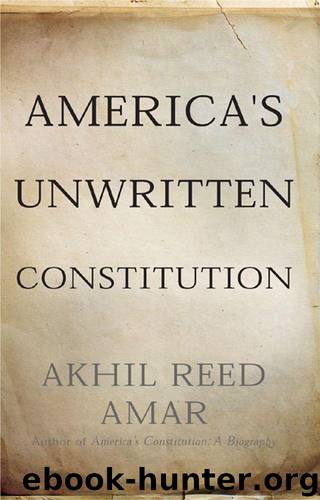America's Unwritten Constitution: The Precedents and Principles We Live By by Amar Akhil Reed

Author:Amar, Akhil Reed [Amar, Akhil Reed]
Language: eng
Format: mobi, epub
ISBN: 9780465033096
Publisher: Basic Books
Published: 2012-09-10T16:00:00+00:00
“the Heads of Departments”
IN ALL THE WASHINGTON ADMINISTRATION EPISODES just canvassed, the president relied heavily on the advice of an inner circle of top executive-branch officials. This heavy reliance bids us take a hard look at the president’s “cabinet”—a word that nowhere appears in the text of the written Constitution as ratified in 1787–1788, but an entity that has played an important role in America’s actual institutional system from 1789 to the present.
Cabinet members are the president’s subordinates, and have been so ever since the days of Washington. America’s first president leaned on his cabinet precisely because he had reason to trust these confidants. He himself had handpicked this team, per the Constitution’s explicit appointments rules. These powerful lieutenants answered directly to him under the Article II opinions clause, which encouraged presidents to require reports from the “principal Officer”—elsewhere described as the “Head[]”—of each executive department. Crucially, these men served at Washington’s pleasure; he had the unilateral power to dismiss them at any time for any reason, and he was willing to wield this power. In 1795, within days of receiving intelligence raising grave doubts about the ethical and political fitness of his second secretary of state, Edmund Randolph (whom he had appointed to replace Jefferson), Washington unceremoniously muscled Randolph out of office, who resigned to avoid being fired.12
But where did the Constitution give presidents this unilateral, plenary, and instantaneous authority to fire the heads of executive departments? Article II explicitly made the Senate a partner in the hiring of department heads. Arguably, the document implicitly gave the Senate a symmetrical role in the firing of these department heads—a reading that would generally require the president to win senatorial consent before firing any cabinet member. (This was the interpretation offered by Hamilton/Publius in The Federalist No. 77.)
However, as soon as Washington took the helm, his supporters in and out of the First Congress (including Hamilton, who on second thought abandoned his earlier interpretation) insisted that the Constitution gave the president a right to fire any executive head in whom the chief executive had lost confidence. After extensive deliberation, the First Congress adopted a series of laws acknowledging this presidential authority in the course of establishing the State Department (originally named the Department of Foreign Affairs), the Department of War, and the Treasury Department. These landmark statutes specified what should happen whenever the principal officer “shall be removed from office by the President”—phraseology artfully designed not to confer removal power upon the president by legislative grace, but rather to concede and confirm the chief executive’s constitutionally derived authority to dismiss executive department heads at will. More than anything in the terse text or the popular understandings that had emerged in the ratification process, it was this set of landmark statutes—today often referred to as the “Decision of 1789”—that established the basic rules of executive-branch firing that govern twenty-first-century practice.13
Granted, a hardcore textualist can insist—as did many of Washington’s supporters in the First Congress, from Madison on down—that the president’s plenary authority
Download
America's Unwritten Constitution: The Precedents and Principles We Live By by Amar Akhil Reed.epub
This site does not store any files on its server. We only index and link to content provided by other sites. Please contact the content providers to delete copyright contents if any and email us, we'll remove relevant links or contents immediately.
The Secret History by Donna Tartt(18843)
The Social Justice Warrior Handbook by Lisa De Pasquale(12141)
Thirteen Reasons Why by Jay Asher(8792)
This Is How You Lose Her by Junot Diaz(6788)
Weapons of Math Destruction by Cathy O'Neil(6142)
Zero to One by Peter Thiel(5685)
Beartown by Fredrik Backman(5594)
The Myth of the Strong Leader by Archie Brown(5424)
The Fire Next Time by James Baldwin(5248)
How Democracies Die by Steven Levitsky & Daniel Ziblatt(5127)
Promise Me, Dad by Joe Biden(5087)
Stone's Rules by Roger Stone(5026)
A Higher Loyalty: Truth, Lies, and Leadership by James Comey(4842)
100 Deadly Skills by Clint Emerson(4840)
Rise and Kill First by Ronen Bergman(4701)
Secrecy World by Jake Bernstein(4643)
The David Icke Guide to the Global Conspiracy (and how to end it) by David Icke(4624)
The Farm by Tom Rob Smith(4434)
The Doomsday Machine by Daniel Ellsberg(4415)
